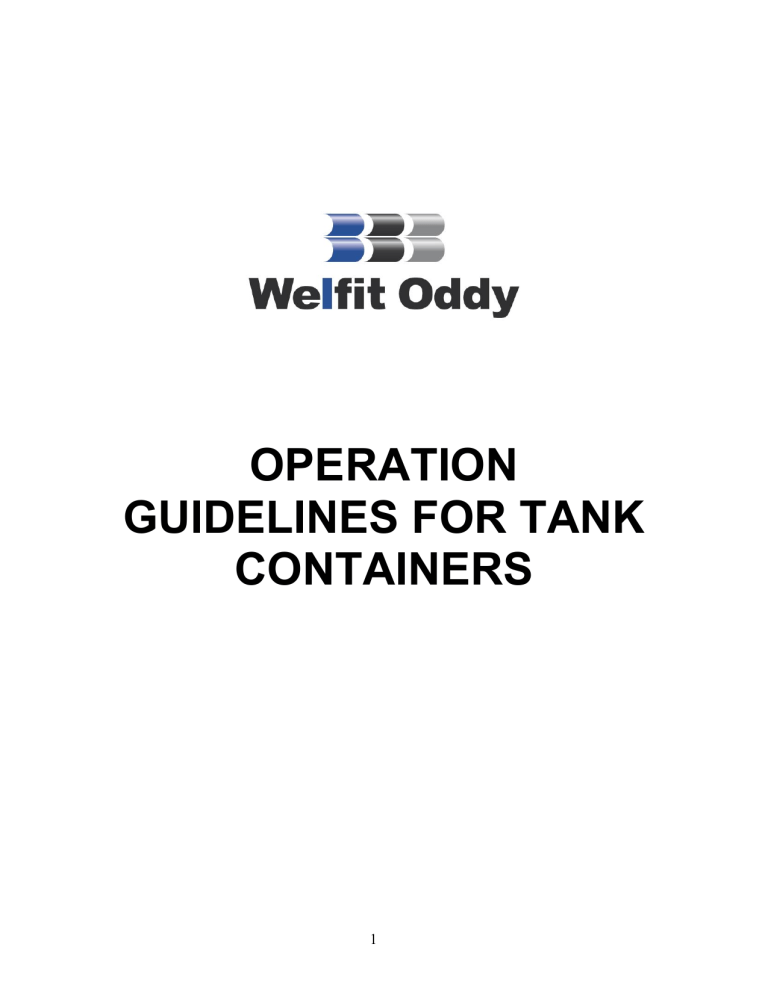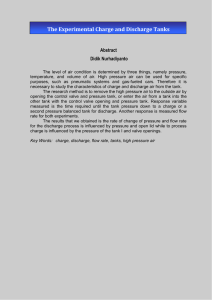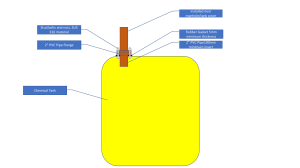
OPERATION GUIDELINES FOR TANK CONTAINERS 1 INTRODUCTION These guidelines have been produced for the safe loading and unloading of standard UN PORTABLE TANK CONTAINERS. NOTE: These tanks often carry hazardous product and the operator should exercise extreme care when handling tank containers. INDEX 1. Loading and Unloading 3 2. Methods of loading 4 3. Methods of discharge 11 DISCLAIMER Welfit Oddy is the manufacture of the tank containers in respect of which these guidelines are written. It must be emphasised the Welfit Oddy is not an expert in the operation and use of tank containers and whilst we have endeavoured to prepare guidelines which will assist the tank container operators in the use thereof, in no respect can Welfit Oddy warrant that these guidelines are without error and omissions and in no respect shall Welfit Oddy incur any liability for any damages whatsoever arising out any errors of omissions therein. 2 OPERATION MANUAL FOR TANK CONTAINERS 1. LOADING AND UNLOADING The choice of method of loading and discharge will depend upon the relative position of the storage tanks and upon the hazard rating or nature of the cargo. 1.1 Cargoes which are not hazardous or noxious and which do not require protection from oxygen or water vapour. These cargoes may be loaded by any of the methods shown in the next sections. 1.2 Noxious or cargoes that exit hazardous vapours Loading or discharge through the top or bottom outlet may be necessary. To create the totally closed system any air, gas or vapour displaced by the liquid, must be returned to the storage tank through a vapour return line fitted between the airline connection and the storage tank. 1.3 Cargoes which must not be contaminated by oxygen or water vapour. These cargoes should be loaded through the top or bottom outlet. The tank should be purged of air before loading and the cargo should be carried under a blanket of inert gas. 1.4 Cargoes which foam or are susceptible to oxidation These cargoes should be loaded through the bottom outlet, or if this is not possible, through the top outlet and siphon tube. 1.5 Measurement of cargo The quantity loaded can be measured on a flow meter, by using a dip rod, or by means of a weighbridge. With hazardous cargoes and “closed system” loading dip rods should not be used. 1.6 Check the complete system All equipment from the main product storage tanks through to the tank container, including valves, hoses, pumps, gauges, connections, vapour return lines etc, should be regarded as a ‘total system’ exposed to the same cargo characteristics, (viscosity corrosivity temperature and pressures), and must be thoroughly checked for suitability and condition. 3 2. METHODES OF LOADING 2.1 Gravity loading Gravity loading through manhole The cargo flows freely from an overhead storage tank through the manhole into the tank container. ‘Closed system’ gravity loading through top or bottom outlets. The cargo flows into the tank container under gravity, the vapours are vented back to the storage tank via the airline connection. 2.2 Pressure loading using pumps Pumped loading through manhole. The cargo is-pumped from the storage tank through the manhole into the tank container, bottom or top connection. Closed System’ pumped loading through top or bottom outlet. The cargo is pumped into the tank container, with vapours vented back to the storage tank via the airline connection. Storage tank vent open or connection to vent line for nitrogen or vapours closed system Vapour return line Vent through open manhole or airline connection or to vent line for nitrogen or vapours closed system, with manlid closed In-line meter In-line meter Alternative connection to bottom outlet Pressure loading using pumps Gravity loading 4 Pressure loading using air pressure The cargo is loaded by top pressure in the storage tank. For sensitive or hazardous cargo, vapours are vented via the airline connection to a vent tank or back to the storage tank. Pressure loading using air pressure 2.3 Safety points to note during loading and discharge There will always be a pressure difference between a closed tank and atmosphere. Valves must be opened carefully. Always relieve pressure before opening the manlid. When using the bottom outlet always open or close the foot valve first. Never enter a tank until all the safety recommendations have been complied with. 2.4 General Instructions before loading 1. Ensure that the vehicle is securely braked, chocking wheels if necessary. 2. Contact the local supervisor to ensure that the cargo is of correct specification and quantity. 3. Where safety or fire fighting equipment is required, it should be positioned upwind of the tank. 4. Make earth connection from tank earthing point to local earth positions. 5 5. Check that the hose connections have the same thread or fitting as the tank connections. Ensure that the correct joint rings and gaskets are the used and that they are compatible with cargo. 6. Check that appropriate facilities exist for the draining of hoses and valves. 7. Check if a Cleanliness Certificate is required (depending on the previous cargo). 8. Open manlid and examine tank/outlet valves for cleanliness. 9. Check relief valves are in sound condition. Note: For cargoes being carried under an inert gas blanket, see section on gas blanketing. 6 2.5 Loading Procedure Through Manhole 1. Refer to Section ‘2.4 for general instructions. 2. Check that all tank bottom valves are closed. 3. Open man lid and insert hose into tank. 4. Secure hose close to the manlid to stop possible whiplash and to prevent the end of the hose coming into contact with the tank surface. 5. Load tank to required level. Check constantly for leaks in hoses and connections. See below 6. Drain hose and remove from tank. 7. Close manlid and tighten down. 8. Refer to Section ‘2.8. 7 2.6 Loading Procedure Through Top Outlet 1. Refer to Section ‘2.4 for general instructions and section 2.3 safety points. 2. Check that all bottom valves are closed. 3. Remove top outlet blank flange. Bolt hose coupling to top outlet flange. 4. Connect vapour return line and open valve to vent tank. 5. Load tank to required level. Check constantly for leaks in hoses and connections. 6. Drain hose, close top outlet valve and remove hose from tank. Replace top outlet blank flange. 7. Close airline valve, disconnect vapour return line and replace blanking cap. 8. Refer to Section ‘2.8 8 2.7 Loading Procedure Through The Bottom Outlet 1. Refer to section 2.4 General Instructions and 3.2 safety points. 2. Remove bottom outlet blank flange or cap, connect hose ensuring connection is correct and tight. Open valves. See below 3. Connect vapour return line and open valve to vent tank. See below 4. Open valves. Load tank to required level. Check constantly for leaks in hoses. 5.a Tanks with single bottom outlet valve: Close valve and then drain hose Disconnect hose and replace blanking cap. 9 5.b Tanks with foot valve and external valve: Close foot valve. Drain hose. Close external valve. Disconnect hose and replace blanking cap or flange. (This sequence is important to ensure that no product remains between foot valve and external valve). See above 6. Close airline valve and disconnect vapour return line and replace blanking cap. 7. Refer to section 2.8 2.8 General instructions after Loading 1. Clean and stow the supply and return hoses, replacing caps and blanks. 2. Ensure that all tank fittings are correctly closed and capped and any cargo spillage removed. 3. Remove earth connection. 4. Replace safety equipment. 5. If required, seal tank and fittings in accordance with. customs requirements See below 6. Check that the tank container is properly labeled for the product loaded, and that any redundant labels have been removed. 10 3. METHODS OF DISCHARGE 3.1 Gravity discharge The cargo flows freely through the bottom outlet to low-level storage tanks. Ensure adequate venting to prevent damage caused by vacuum. 3.2 Pressure discharge using compressed air The cargo is discharged through the top or bottom outlets by top pressure in the tank container. Products carried under an inert gas blanket are normally discharged using nitrogen or another inert gas as the pressure medium. The maximum working pressure of the tank must under no circumstances be exceeded. Venting through open manhole or airline connection Gravity discharge Gas or Air pressure Supply In-line meter Pressure discharge using air. 11 3.3 Pumped discharge The suction side of a suitable pump maybe connected to the top or the bottom outlets or to a hose via the manhole to pump the cargo to higher level storage tanks. Air or gas must be allowed into the tank container to replace the cargo being discharged. Depending on the nature of the cargo this can be achieved by opening the man lid or airline connection. or by connection to an inert gas supply. When using a high capacity pump it is recommended that a vacuum safety valve is incorporated in the suction line to protect the tank from vacuum collapse. Venting through open manhole or airline connection. Storage tank vent open or connected to vent line for nitrogen or vapours closed system. Vent through open manhole or airline connection or to vent line for nitrogen or vapours closed system, with man lid closed. Storage tank vent open or connection to vent line for nitrogen or vapours closed system Vent through open manhole or airline connection or to vent line for nitrogen or vapours closed system, with manlid closed In-line meter Alternative connection to bottom outlet Pumped discharge 12 3.4 Procedure Before Discharge 1. Ensure that the vehicle is securely braked, chocking wheels if necessary. 2. Contact the local supervisor to ensure that there is adequate space in the receiving tank. If product is already present in the receiving tank check that it is identical to the cargo being discharged. . 3. Where safety or fire fighting equipment is required, position it upwind of the tank. 4. Make earth connection from tank earthing point to local earth positions. 5. Check that the hose connections have the same thread or fitting as the tank connections. Ensure that the correct joint rings and gaskets are used, and that they are compatible with the cargo. 6. Check appropriate facilities exist for the draining of hoses and valves. 7. Check the setting the off valves to the receiving tanks. 8. For discharge by pumping or by gravity ensure that the danger of implosion is avoided by opening the man lid (or airline valve to vapour return line if closed system is being used). Ensure that venting is not prevented by any solidified cargo in the airline or relief valves. See below 9. For discharge with top pressure ensure a gauge is visible and in a serviceable condition to monitor the pressure applied. 10. It will assist discharge through top or bottom outlet if the tank is sited to drain towards the rear. 11. Notify the station supervisor when the tank is ready for discharge. Note: For cargoes being carried under an inert gas blanket, see section on gas blanketing. 13 3.5 Procedure For Gravity Discharge 1. Refer to section 3.4 before discharge and 2.3 safety points. 2. Remove bottom outlet blanking cap or flange and connect hose ensuring that the connection is correct and tight. 3. Open man lid or airline to vent the tank or vent back to storage. See below 4. Open outlet valves and commence discharge. Check constantly for leaks in hoses and connections. see above. 5. Drain tank. When discharge is complete. 6.a Tanks with single bottom Close valve and drain hose. Disconnect hose and replace blanking cap or flange. 6b. Tanks with foot valve and external valve: Close foot valve. Drain hose. Close external valve. Disconnect hose and replace blanking cap or flange. (This sequence is to ensure that no product remains between foot valve and external valve). 14 7. Close man lid and tighten down or close airline connection and replace blanking cap. See below 8. Refer to section after discharge. . 15 3.6 Procedure For Pumped Discharge 1. Refer to section 3.4 before discharge and 2.3 safety parts. 2.a Top outlet discharge: Remove top outlet blank flange, bolt hose couplings to top outlet flange. 2.b Bottom outlet discharge Remove bottom outlet blanking cap or flange, connect hose ensuring that hose connection is correct and tight. See below 3. Open manlid or airline connection to vent tank. See below 4. Open tank outlet valve or valves and commence discharge. Check constantly for leaks in hoses or connections. See below 16 5. Drain tank. 6. When discharge is complete. 6.a Top outlet discharge: Drain hose, close top outlet valve and remove hose from tank. Replace top outlet blank flange. 6.b Tanks with single bottom outlet valve: Close valve and then drain hose Disconnect hose and replace blanking cap or flange. 6.c Tanks with foot valve and external valve: Close foot valve. Drain hose. Close external valve. Disconnect hose and replace blanking cap or flange. (This sequence is important to ensure that no product remains between foot valve and external valve). See below 7. Close man lid and tighten down, or close airline connection, replacing blanking cap. 17 8. Refer to section ‘After discharge’. 3.7 Procedure Pressure Discharge 1. Refer to section 3.4 before discharge AND 2.3 SAFETY PARTS. 2.a Top outlet discharge: Remove top outlet blank flange, bolt hose couplings to top outlet flange and open top outlet valve. Note: The syphon tube extends to approximately 12 mm from tank bottom at outlet of tank, so that the minimum of cargo remains after discharge via top outlet. See above 2b. Bottom outlet discharge: Remove bottom outlet blanking cap or flange, connect hose, ensuring that hose connection is correct and tight, open foot valve (if fitted) and open outlet valve. See above 18 3. Connect airline and open airline valve (if fitted). See above 4. Open tank outlet valve or valves and commence discharge. Check constantly for leaks in hoses or connection. 5. Apply pressure until discharge is completed. (not exceeding tank and hose working pressure in general should not exceed 1 bar). Check constantly for leaks in hoses and connections. Pressure will drop when discharge is complete. 6. When discharge is complete, and hose line is empty, close - airline valve, disconnect airline and replace blanking cap. Note: It is important to relieve any remaining pressure in the tank through the hose when noxious and hazardous vapours are present. See below 19 6.a Bottom outlet discharge: Tanks with single bottom outlet valve: Close valve and then drain hose. Disconnect line and replace blanking cap or flange. 6.b Tanks with foot valve and external valve: Close foot valve. Drain hose. Close external valve. Disconnect hose and replace blanking cap or flange. 3.8 Procedure After Discharge 1. Check the tank is completely empty. 2. Stow hoses, replacing caps and blanks. 3. Ensure that all tank fittings are correctly closed and capped and any cargo spillage removed. 4. Remove earth connection. 5. Replace safety equipment. 6. In the case of hazardous cargo, the tank must be regarded as dangerous until clean and gas free. 7. Where cargo residue may spoil or may become corrosive the tank with atmospheric air or humidity, the nitrogen used to discharge the tank should remain in the tank until it is cleaned or reloaded with cargo. 20 8. To prevent hardening of solvent soluble resins and paints, approximately 15 litres of solvent should be added to the tank and the tank should be maintained under pressure awaiting cleaning. 9. To prevent drying out of latex and emulsions, the tank should be maintained under air pressure awaiting cleaning. 21




